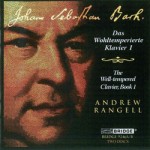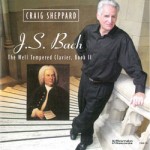Column Name
Title
Chances are any serious pianist will eventually be seduced into tackling Bach’s Das wohltemperierte Klavier (better known in English as The Well-Tempered Clavier), one of the monuments of Western music. In addition to demonstrating the virtues of a tuning system that accommodates all 24 keys, Bach designed the two books of 24 preludes and fugues each to be performed by both beginning and veteran players. What student—of any instrument—has not encountered the Prelude No. 1 in C from Book I? From all over the world, harpsichordists and pianists have been attracted to—and tested by—the cycle. The composer never intended either book to be played from beginning to end in one sitting, though more and more, pianists are taking on that challenge in concert and on recordings. Before listening to the discs reviewed here, I revisited Till Fellner’s recent version of Book I (on ECM) and Glenn Gould’s classic Book II (on Sony Classical).
Body
Here, two recent additions to the catalog show quite different approaches. Andrew Rangell, who earned a doctorate from Juilliard in 1976, adopts an idiosyncratic outlook in his reading of Book I, bringing out details in unexpected ways. Using a Hamburg Steinway Model D, he is frugal with the pedal, producing a beefy tone and powerful attacks.
His strongly articulated touch gives crispness to many of the lines, and in some, his speedy dispatch is engagingly virtuosic yet without a trace of self-consciousness. For example, the Fugue No. 7 in E-flat Major is delightful, almost staccato, with deftly done ornaments. Evident in many is a sense of wonder—as if he just discovered the music this morning—while others share a fitful feeling, as if the pianist had a bit of insomnia and arose in the middle of the night to play. Rangell’s spiky treatment of the F-sharp Minor Prelude (No. 14) will have your heart pounding, as will its brief, big-hearted successor in G Major. Many show rhythmic flexibility. The recorded sound is pleasant and on the close-in side, taped in Boston’s Gardner Museum by Thomas Stephenson.
In his notes on Book II, Craig Sheppard (B.M. '70, M.S. '71, piano) comments on the dearth of “wonderful, slow, ruminative and often tragic fugues” found in Book I, but goes on to cite some of those in Book II as among the composer’s grandest achievements. Certainly Sheppard plays these with a mixture of understatement and bravado—and that’s not as oxymoronic as it may sound. Recording engineer Dmitry Lipay, audio producer for the Seattle Symphony, adds his expertise to create a sound that is easy on the ear. Working in Seattle’s Meany Theater, he captures Sheppard’s luminous tone and carefully nuanced dynamic levels.
Like Rangell, Sheppard also chooses a Steinway Hamburg D, and shows precision plus agility to spare: his Prelude in D Major fairly springs off the page, with expertly dispatched trills and near-ideal balance. Sample his elegance in the G Major Prelude and the brief fugue that follows. Throughout, Sheppard reveals poetry: tenderness in the Prelude in E-flat Major, or intimacy in the F-sharp Minor’s delicate strands. And as the cycle reaches its close, Sheppard acknowledges the journey with some well-chosen pauses, as if a gigantic object is slowly coming to rest, and at the end, the applause may come as a surprise: he enjoys a remarkably quiet audience.
In his thoughtful notes, an amused Sheppard focuses on the startling chromaticism in the A-minor Prelude, edited by Johann Chrisoph Altnickol, and speculates that he and Bach may have dreamed it up after imbibing too much beer and wine. It’s true: this Prelude would not be out of place in Conlon Nancarrow’s Studies for Player Piano.






